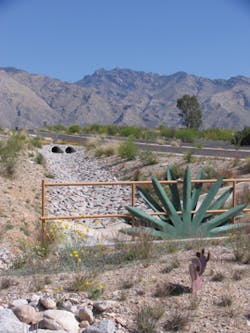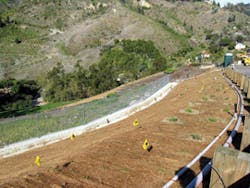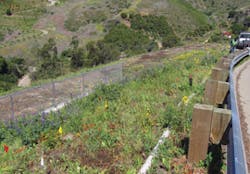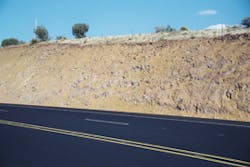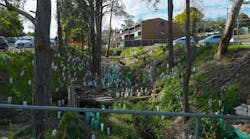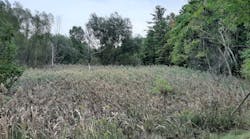Hot and dry weather. Time constraints. Soil conditions.
All of these factors can significantly affect a temporary or permanent revegetation project.
By properly preparing the soil and using seed mixes that can withstand climate changes, contractors who are doing revegetation projects are meeting those challenges with success.
In Owasso, OK, two manmade 90-degree bends on a channel with slopes had eroded and began presenting problems.
“The slopes sloughed off and had fallen down into the channel, which had pushed more of the water into the 90-degree bend even sharper, so it was a continual, progressive erosion problem on both of those bends,” notes Daniel Dearing, the city’s senior civil engineer.
Dearing sought a green soft-armor solution for the high-flow channel as opposed to concrete or rock riprap. Aesthetics were another consideration. Trails adjoin the channel. Water trickles over low dams to create the sound of running water.
Dearing and his staff chose solutions from Pennington Seed Co.-including the use of Enkamat 7020 and Profile Products’ FlexTerra-after hearing what the company had to offer at a “lunch and learn” session and considering other options.
“We sent off our seed mixture to Pennington Seeds, and they came back with their recommendation. We used their recommendation, which incorporated a lot of the natives,” says Dearing. “We didn’t want to use just Bermuda, because we knew it wouldn’t survive underwater applications. We knew there needed to be a special blend. We are not seed experts, and we did not know what would do well under the water and what would do well along the slopes, so they came up with their determined blend.”
The blend included fast- and slow-growing species.
“They have something that quick-sprouts and have some slower germinating seed. My staff and I rely on their expertise,” says Dearing.
The Sycamore Canyon Road landslide area during planting and after revegetation
Beyond the seed concerns were soil challenges. “We had some sandy silt, silty clay, and fat clays we had to deal with,” says Dearing. “We also found some junk that was buried in there; it looked like old landfill material.”
Unusually hot and dry conditions required more watering than usual. Ultimately, the re-vegetation has come along nicely, Dearing notes.
After the Landslide
Underground springs had caused a landslide along Sycamore Canyon Road in Santa Barbara, CA, in an area that encompassed residential homes.
While the California Department of Transportation (Caltrans) mitigation efforts have been going on for some time, Arcadia Studio Landscape Architecture in Santa Barbara was called upon to provide revegetation from March to June 2012. Arcadia’s approach entailed hydroseeding and the installation of native container plants to stabilize the area.
Arcadia sourced its seeds from S&S Seeds. The seed mix again included both fast-growing species and slower-growing plants.
The hydroseed mix included white yarrow, California brome, blue wild rye, golden yarrow, California poppy, meadow barley, climbing penstemon, dwarf goldfields, tidy-tips, giant wild rye, deerweed, miniature lupine, succulent lupine, Coast Range melic, sticky monkeyflower, purple needlegrass, blue-eyed grass, and small fescue.
“We always put in a cover crop,” notes Carroll. “Usually it’s vulpia [small fescue] and California brome-it gives you that quick germination-and some of the other slower-growing chaparral-type plants. Some of those take months to get much bigger than a few inches.”
Additionally, the company used 5,000 1-gallon container plants, grown ahead of time for the project, with some matching what was in the hydroseed mix.
It has become the norm to use all-native plants on such a project, Carroll notes. “You can take the irrigation off after a couple of years, maybe even one year,” he says. His company used an aboveground irrigation system that provided a wide range of coverage.
Although Arcadia did not use any soil amendments or fertilizers in this project, Carroll says it can be useful to use mycorrhizal inoculants in the slurry mix to be sprayed on the ground to help establish seed.
The project entailed significantly steep slopes. There were three types of soil on the site: The top of the slope is hard clay; the middle is shale-like; and the bottom is wet. Time was also a challenge, as the revegetation had to be established right away.
Arcadia also used a North American Green coconut-fiber erosion control blanket. “It has more durability and lasts longer than a typical jute mat,” says Carroll.
Based on this project, Carroll says he would not recommend planting Keckiella cordifolia (climbing penstamon) in similar conditions. “A lot of that plant died,” he says. “It is very temperamental. If someone really wants to try it, it is probably best to try it from seed instead of as a container plant.”
Working on Federal Lands
Two years ago, KCI Environmental was called upon to do up to 20 acres of hydroseeding for a revegetation project at San Antonio Creek at Vandenberg Air Force Base near Lompoc, CA.
“The creek had gotten torn up over the past winters, and the sides were starting to collapse,” says Jim Gorter,
An eroding embankment near Arizona’s Gila River
vice president of KCI Environmental. “The banks were head-cutting and falling in. They recontoured the bottom and put in rock drop structures so that when the water really rushed through there, these structures would slow down the velocity of the water and allow it to drop to a lower elevation without causing too much erosion damage.”
KCI Environmental applied three different seed mixes. One was a riparian mix including grasses and shrubs that grow close to the water’s edge. An upland and a meadow component were also included. The company also used products from Mycorrhizal Applications.
Since then, the company has been doing monthly maintenance to keep the weeds contained and installing more willow cuttings where needed to try to rebuild the willow bank that grows along the edge of the creek.
Because it was a federal government job, it required the use of native seed. Additionally, the Air Force base did not want a nurse crop planted.
“A normal nurse crop would have been a cereal grain like barley or oats,” says Gorter. “We do that occasionally on other projects to get a quick established cover. The natives work through it and out-compete the nurse crop in the long run. On this project, because it was environmentally sensitive and there were endangered plants in there, they didn’t want these introduced or exotic species competing with them. They stayed pretty much with a straight native seed mix.”
The job also called for species collected from the nearby area, within a 50- to a 100-mile radius of the project site. Because of the proximity to the creek, no fertilizers or soil amendments could be used, given the potential for runoff into the creek.
Weather and time constraints usually pose challenges, Gorter notes. “We’re always pushed at the very last minute to get this done before the rainy season starts, and this project was no different,” he points out. “The hydroseeding installation went smoothly. We hydroseeded and then applied a straw cap to some of the upland areas to help retain whatever moisture we got, because they were going to rely on natural rainfall. Then we had to deal with all of the weed species that came up the following spring. There was a restriction for herbicide use, so we had to send crews in there to remove the weeds manually.”
Planting a Pipeline
Price Gregory International is an infrastructure services company that must often do revegetation projects as part of its work constructing oil-and-gas pipelines as well as other infrastructure projects.
Clint Littleton, who handles purchasing for the company, says his company often doesn’t have a say in what type of seed is used in a project, as that is often decided upon by the client or regulatory agencies.
Case in point: a recent 12-mile project in which another company had laid the pipe, ran out of money to finish the job, and then went out of business.
“We came in to clean it up, reseed it, and revegetate the slopes,” notes Littleton.
For this project, Price Gregory used a required mix formulated for wetlands from Ernst Conservation Seeds as well as a standard mix that goes on all projects. The company also uses deer clover and, in other projects, any other type of seed the landowner requests.
Annual rye also is part of the mix, and it comes up fast, Littleton notes.
The company also blows straw onto the site with the seed mix. Despite heavy weekly rains and the rocky soil, the seed application has come up nicely, says Littleton.
Price Gregory also planted some 7,000 trees and shrubs on each side of a stream on site to deal with potential erosion in the wetlands area. In addition to the seed, the company used a 10-20-20 fertilizer and lime.
Revegetation in an Arid Climate
Arizona’s climate and soils can be challenging for those engaged in revegetation efforts. Such is the case for Joy Lyndes, RLA, ASLA.
She is the lead landscape architect in the Tucson office of Sage Landscape Architecture & Environmental, part of the international firm Kimley-Horn, and president-elect of the Arizona chapter of the American Society of Landscape Architects.
Her firm has done a number of projects for the Arizona Department of Transportation in environmentally sensitive remote areas near regulated waters. One such project was at a bridge crossing on the Gila River, where there are jurisdictional waters and biological species of special status along the corridor, Lyndes notes.
“We would do inventories in advance of the project to figure out what our plant communities are and also identify where we might have some special-status species and evaluate how to mitigate the impact,” she says. “Almost always in the case of this project, there is revegetation, including seeding, and also pole-planting in the wetlands and riparian areas.”
Other projects that call for seeding are parks, recreation trails, and flood control projects for Pima County. Lyndes points out that there is always some type of restoration work that needs to be done as part of the scope of work.
Seed requirements depend on the project, Lyndes says.
“Many of the projects we work on are considered environmentally sensitive, which means there is a reason to pay attention to what the species are on the site and then restore the project with those same species,” she points out. “Our seed mix is derived from the species that exist.”
For an environmentally sensitive roadway, for example, Pima County requires a biological inventory of the native plants and several tiers of detailed inventories.
“We get the annuals, perennials, trees, and the cactus and then revegetate with the seed mix, and we replant some of the cactus and the trees,” Lyndes says. “We don’t require that our contractor collect seed onsite, but we do identify the genus and the species; sometimes the varieties of the seed they collect are somewhere nearby. If it’s not in Arizona, then it would come from New Mexico.”
Seed mixes are a combination of native grasses and flowers, especially if the company is aiming for something more aesthetic or decorative with perennials and some annuals.
“We have a range of types of seed mixes, depending on where we’re revegetating,” says Lyndes. Road projects, for example, typically call for the company to design with low-growing plants.
“What’s most important to any seed mix is that we get a good balance of the broader leaf plants with the grasses,” she adds. “That will help stabilize the soil the quickest.”
The company obtains soil tests to determine the soil condition and ensure it’s in a state that fosters germination. The desert soils tend to have salt buildup and caliche layers, creating a “hard” soil, Lyndes says.
In addition to seeding, Sage Landscape Architecture & Environmental uses a variety of erosion control techniques, such as matting and sediment logs.
In this time of extreme drought in many places throughout North America, irrigation of a new project is a prime concern. “We have an interesting challenge here in the desert,” Lyndes notes. “Studies have been done by the University of Arizona on irrigated reseeding versus non-irrigated. Fifteen to 20 years ago, we used the practice of irrigating our seed when we installed it, because irrigated seed definitely comes up quicker. But it’s been demonstrated over time that a non-irrigated seed mix is as successful as an irrigated seed mix-it just takes longer to come up.”
The Arizona Department of Transportation has invested a great deal of time in construction detailing for successful seeding without irrigation, Lyndes adds. Based on that approach, Sage Landscape Architecture & Environmental takes care to ensure that a seedbed is properly prepared.
“Our soils can be pretty consolidated here,” says Lyndes. “We need to rip the soil down to 6 to 12 inches and make it rough and uneven and then apply the seed with a mulch and a tackifier. Sometimes on a slope, we need to put in mini-benches to make sure the water doesn’t concentrate as it rolls off the slope and that it infiltrates better.”
The company aims to time the seeding prior to the region’s rainy season. “We primarily have a monsoon rainy season in summer, but sometimes we also get rains in the winter,” Lyndes notes. “Our rains are pretty predictable. If we can time our construction so that the seed goes down right before that, that’s the best.”
It always doesn’t work out that way, though.
“Typically, our seed will be installed and it will sit there and wait for the rains because that’s really what it needs to germinate,” Lyndes adds. “We want the water to germinate the seed and be successful, but it cuts both ways. The water can also really damage the seeding project, because when it comes, it comes hard.
“Stabilizing our soil aggressively when we’re seeding is the most successful way to approach a good seeding operation, because we need to anticipate that the rain may come really hard when it comes, and we want to keep our soil in place so that it can be successful,” she says.
Copying Native Ecosystems
Carolyn Edsell-Vetter, MCH, AOLCP, is a designer and horticulturalist with A Yard & A Half Landscaping, located in Waltham, MA.
“We’re a design-build landscaping company. So a lot of times, if I’m doing a revegetation project, I’m on a property that’s been disturbed near a wetland or where erosion has happened over time because it’s a large area that has been degraded,” she says.
“The first thing I do is look at relatively healthy surrounding ecosystems; if it mimics something that’s there, I know it is going to do well.”
Edsell-Vetter looks to plant native material.
“Ideally, if I can use plugs or stakes rather than seed, that’s my preference,” she says. “But obviously for a large area, seed is often going to be the most cost-effective.”
If the project entails a wetland buffer, native seed must be used.
“A lot of the time, it’s a consideration of what’s going to function best,” she says. “If I can at least put a good percentage of natives in there, that’s my preference.”
Like many others, she prefers a combination of fast-growing and slow-growing species: nurse crops along with succession plantings. That’s especially critical in a less-managed area, she adds.
Edsell-Vetter favors a mix of grasses and fescues as a quick-generating nurse crop, adding it depends on site conditions.
“If I’m not working from seed, I prefer to use some shrubs, some sumacs, some dogwood-anything with a colonizing root system to it,” she says.
Her company also uses organic approaches. “We use soil amendments,” she says. “We try to use what’s going to be a fuller release rather than a one-shot fertilizer because of organic concerns around not creating excess nutrients, and also because this is an area that is less managed.
“When working on a slope, you want to have as little to do with maintenance as possible, so we would rather get the soil in good condition to start out with. That’s preferable to having to come back and fertilize every time.”
Edsell-Vetter may encounter a range of soil conditions, from dry, sandy slopes where a lot of good topsoil has already been eroded to ledge-type areas that are mostly rock with a thin layer of topsoil.
“Our native soils are actually pretty good,” she says. “But sometimes all of the good stuff has already washed away.” Thus, she uses as much compost as the project budget will allow.
Edsell-Vetter aims to plant at a time when germination is optimal, such as in April, August, or September.
“The bigger concern is rain washing stuff away after seeding,” she says. “Sometimes we know we’re going to have to come back and do a follow-up, so we hope we get less rain until it germinates. We just keep it wet. Depending on the site and its size, we may put irrigation or a temporary drip system in to get stuff going.”
Time constraints focus on the expectations of “immediate gratification” with some property owners in the residential sector.
The removal of some plants to make way for better species and having to let the ground “cook” under plastic for awhile to prepare it for planting doesn’t always sit well with some people, Edsell-Vetter notes.
“People aren’t always thrilled with that, but sometimes that’s what it takes when you’re working with natural systems,” she says.